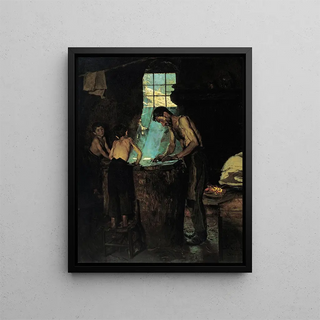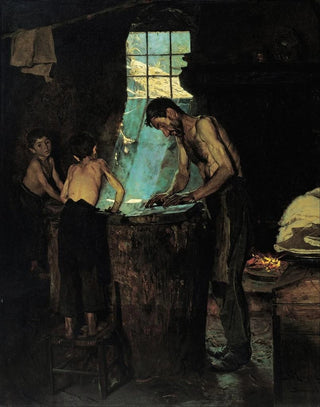Art print | Hatmakers in an Italian village - Peder Severin Krøyer


View from behind

Frame (optional)
In a peaceful corner of Italy, where light dances on cobbled streets and houses painted in warm hues, Peder Severin Krøyer captures the essence of village life through his artwork "Hats Makers in an Italian Village." This painting, imbued with tenderness and serenity, invites us to immerse ourselves in a frozen moment, where time seems to stand still. The hat makers, iconic figures in this scene, are busy at their craft, creating an atmosphere of conviviality and authenticity. The scene, bathed in golden light, evokes not only the beauty of simple daily life but also the richness of human interactions taking place within it.
Style and uniqueness of the artwork
Krøyer's style is distinguished by his ability to capture light and color with remarkable finesse. In "Hats Makers in an Italian Village," he employs warm tones and delicate shadows to bring each character and element of the setting to life. The composition, both harmonious and dynamic, highlights the interaction between the hat makers while subtly integrating the surrounding landscape. The meticulous details, such as the textures of clothing and facial expressions, testify to a striking realism. This artwork does not merely depict a scene from everyday life; it also evokes a sense of nostalgia and timeless beauty, inviting viewers to reflect on the simplicity and richness of shared moments.
The artist and his influence
Peder Severin Krøyer, a major figure of the Scandinavian painters' movement, successfully integrated Impressionist influences into his work. Born in 1851, he spent part of his life in France, where he was inspired by the great masters of the time. His innovative approach to light and color marked a turning point in Scandinavian art, paving the way for a new way of perceiving and representing reality. Krøyer also played a key role in the development of the Skagen school, a group of artists who gathered to capture the beauty of Danish landscapes. His artwork "Hats Makers in an Italian Village" reflects this quest for

Matte finish

View from behind

Frame (optional)
In a peaceful corner of Italy, where light dances on cobbled streets and houses painted in warm hues, Peder Severin Krøyer captures the essence of village life through his artwork "Hats Makers in an Italian Village." This painting, imbued with tenderness and serenity, invites us to immerse ourselves in a frozen moment, where time seems to stand still. The hat makers, iconic figures in this scene, are busy at their craft, creating an atmosphere of conviviality and authenticity. The scene, bathed in golden light, evokes not only the beauty of simple daily life but also the richness of human interactions taking place within it.
Style and uniqueness of the artwork
Krøyer's style is distinguished by his ability to capture light and color with remarkable finesse. In "Hats Makers in an Italian Village," he employs warm tones and delicate shadows to bring each character and element of the setting to life. The composition, both harmonious and dynamic, highlights the interaction between the hat makers while subtly integrating the surrounding landscape. The meticulous details, such as the textures of clothing and facial expressions, testify to a striking realism. This artwork does not merely depict a scene from everyday life; it also evokes a sense of nostalgia and timeless beauty, inviting viewers to reflect on the simplicity and richness of shared moments.
The artist and his influence
Peder Severin Krøyer, a major figure of the Scandinavian painters' movement, successfully integrated Impressionist influences into his work. Born in 1851, he spent part of his life in France, where he was inspired by the great masters of the time. His innovative approach to light and color marked a turning point in Scandinavian art, paving the way for a new way of perceiving and representing reality. Krøyer also played a key role in the development of the Skagen school, a group of artists who gathered to capture the beauty of Danish landscapes. His artwork "Hats Makers in an Italian Village" reflects this quest for






